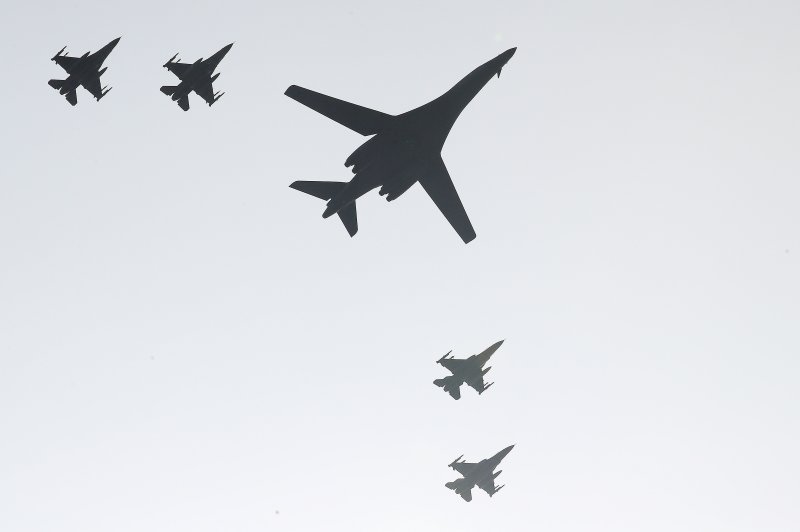One of two B-1B Lancer bombers (C) deployed by the U.S. military and four South Korean F-15K fighters fly over Osan Air Base, south of Seoul, on Sept. 13. The United States had proposed Japan’s fighter jets be allowed to fly in formation but Seoul turned down the idea, according to a Japanese newspaper. Photo by Yonhap/UPI
SEOUL, Oct. 18 (UPI) -- South Korea turned down a U.S. proposal to allow Japanese fighter jets to fly in South Korean airspace in September.
Seoul did not warm to the idea of aerial bombers of Japan's air self-defense force joining U.S. and South Korean aircraft for a joint drill, Japanese newspaper Asahi Shimbun reported Tuesday.
But neither were South Korea's F-15 fighter jets allowed to fly over Japanese airspace, while en route to a separate training mission in Alaska, according to the report.
In September the United States flew two B-1 bombers over South Korea in response to North Korea's fifth nuclear test on Sept. 9.
The B-1B Lancers flew with U.S. F-16 and South Korean F-15 fighters over Osan Air Base as part of the U.S. plan of "extended deterrence" on the peninsula.
Prior to the drills, the United States had suggested Japan's forces be allowed to train alongside U.S. and South Korean pilots.
A source who spoke to the Asahi on the condition of anonymity said as Seoul, Tokyo and Washington were seeking new sanctions in response to North Korea's fifth test, the United States proposed the fighter jets of the three countries "fly in formation."
But South Korea had said "it would be difficult to allow Japan's air self-defense force to fly in South Korea airspace due to national sentiment," according to the source.
Japan also holds restrictions against the deployment of foreign aircraft. The Status of Forces Agreement between the United States and Japan only allows U.S. military aircraft in sovereign airspace.
In response to North Korea provocations, South Korea has been stepping up reviews of its missile defense systems, Yonhap reported Tuesday.
Seoul's defense ministry is expected to accelerate the development of a "three-axis system" that includes homegrown anti-missile systems, the Korean Air and Missile Defense, or KAMD; Kill Chain, a pre-emptive strike system; and Korea Massive Punishment and Retaliation, or KMPR, a plan to target the North Korean leadership in the case of a strike.















